Did you know that pre-colonial Filipinos navigated vast oceans using only the stars and their understanding of the solar system? Long before modern technology, indigenous communities in the Philippines developed sophisticated methods to observe the sky. These practices were not just for navigation but also guided their agricultural cycles, fishing seasons, and daily lives.
For example, the Ayta of San Marcelino used the lunar cycle to create their agricultural calendar. They defined a month by the appearance of a new moon, resulting in 12 months per year. Similarly, the Sama of Tawi-Tawi relied on Polaris, known as Mamahi Utara, as a fixed reference point for maritime navigation.
These early observations of celestial bodies showcase the deep connection between the natural world and human survival. Pre-colonial Filipinos didn’t just look at the sky; they integrated their knowledge into their culture, creating a legacy that continues to inspire modern astronomy.
Key Takeaways
- Pre-colonial Filipinos used the stars and solar system for navigation and daily life.
- Lunar cycles guided agricultural calendars, such as the Ayta’s 12-month system.
- Polaris (Mamahi Utara) was a key reference point for maritime navigation.
- Celestial observations influenced cultural practices and survival strategies.
- These methods laid the foundation for modern astronomical understanding.
Introduction to Pre-Colonial Philippine Astronomy and Navigation
Long before modern tools, ancient Filipinos mastered the art of navigating vast seas using celestial cues. Their deep understanding of space and natural phenomena shaped their daily lives, from agriculture to cultural rituals. This knowledge was not just practical but also deeply rooted in their connection to the environment.
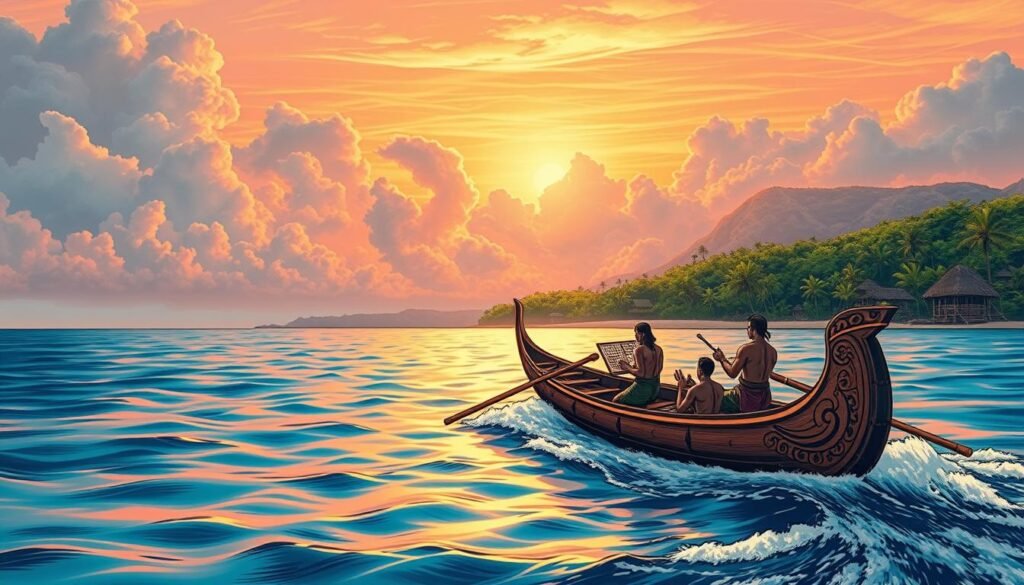
Pre-colonial communities relied on the stars, moon, and sun to guide their journeys. For example, the balangay, an ancient wooden boat, was used for maritime travel. These vessels were essential for trade and exploration, showcasing the ingenuity of early Filipino science.
Celestial observations also played a vital role in agriculture. The lunar cycle determined planting and harvesting seasons, ensuring sustainable farming practices. This integration of energy from natural phenomena highlights the advanced understanding of the cosmos among pre-colonial Filipinos.
Below is a table summarizing key aspects of pre-colonial astronomy and navigation:
| Aspect | Application |
|---|---|
| Stars | Navigation and timekeeping |
| Lunar Cycle | Agricultural calendar |
| Solar Position | Seasonal markers |
| Natural Phenomena | Cultural rituals |
These methods were not just practical but also deeply embedded in the cultural fabric of pre-colonial societies. They laid the foundation for modern scientific understanding and continue to inspire today.
Historical Context and Cultural Significance
The skies have always been a guide for ancient civilizations, including pre-colonial Filipinos. Their understanding of the system of celestial movements was not just practical but deeply cultural. This knowledge shaped their daily lives, from navigation to agriculture.
Across the globe, many cultures developed similar methods to interpret the heavens. For example, the Babylonians used the moon to predict planetary movements as early as the 2nd millennium BCE. Similarly, pre-colonial Filipinos relied on the lunar cycle to time their planting and harvesting seasons.
Celestial objects like the moon and stars were more than just markers of time. They were woven into the fabric of indigenous identity. Oral traditions passed down stories of how these objects guided their ancestors across vast oceans. This blend of practical knowledge and cultural storytelling enriched their heritage.
Comparing these practices with other ancient systems reveals fascinating parallels. The Nebra sky disc, dating back to 1600 BCE, depicts the moon and stars, much like how pre-colonial Filipinos used them. These shared methods highlight a universal human connection to the cosmos.
Historical narratives and oral traditions played a crucial role in preserving this knowledge. They ensured that each generation understood the importance of the system of celestial navigation. This legacy continues to inspire modern understanding of the skies.
Indigenous Star Mapping and Celestial Observations
Long before the invention of the telescope, indigenous Filipinos charted the night sky with remarkable precision. They relied on their deep connection to the earth and its natural rhythms to create early star maps. These maps were not just tools for navigation but also cultural artifacts that reflected their understanding of the cosmos.

Ancient Instruments and Techniques
Without modern tools, pre-colonial Filipinos used simple yet effective methods to observe the heavens. They relied on natural landmarks, like mountains and rivers, to align their observations. For example, the position of the sun during solstices was marked using stones or wooden stakes.
Oral traditions also played a crucial role. Elders passed down knowledge of star patterns and their meanings through stories and songs. This ensured that navigational techniques and seasonal markers were preserved for generations.
Oral Traditions in Navigational History
Storytelling was more than entertainment; it was a way to preserve vital knowledge. Tales of celestial journeys guided sailors across vast oceans. These stories often included detailed descriptions of star clusters and their movements, serving as a living map of the night sky.
For instance, the Sama people of Tawi-Tawi used the star Polaris, known as Mamahi Utara, as a fixed point for navigation. This knowledge was embedded in their oral traditions, ensuring its survival even without written records.
Below is a table comparing indigenous methods with later technological advancements:
| Method | Indigenous Techniques | Modern Advancements |
|---|---|---|
| Star Mapping | Relied on oral traditions and natural landmarks | Uses telescopes and digital software |
| Navigation | Used fixed stars like Polaris | GPS and satellite technology |
| Understanding of the galaxy | Based on cultural interpretations | Scientific exploration and imaging |
These early methods laid the groundwork for modern astronomy. While tools like the telescope have revolutionized our understanding of the universe, the ingenuity of indigenous star mapping remains a testament to human curiosity and adaptability.
Astronomy in Pre-Colonial Philippines
Pre-colonial Filipinos had a deep understanding of the cosmos, studying planetary movements and celestial events with remarkable precision. Their systematic observation of the skies was not just for navigation but also shaped their cultural practices and daily lives.
Early Filipinos actively tracked the positions of planets and stars. They used natural landmarks like mountains and rivers to align their observations. For example, the constellation Balatik, known as “Tres Marias,” was a key marker for the planting season. Its appearance signaled the start of agricultural activities.
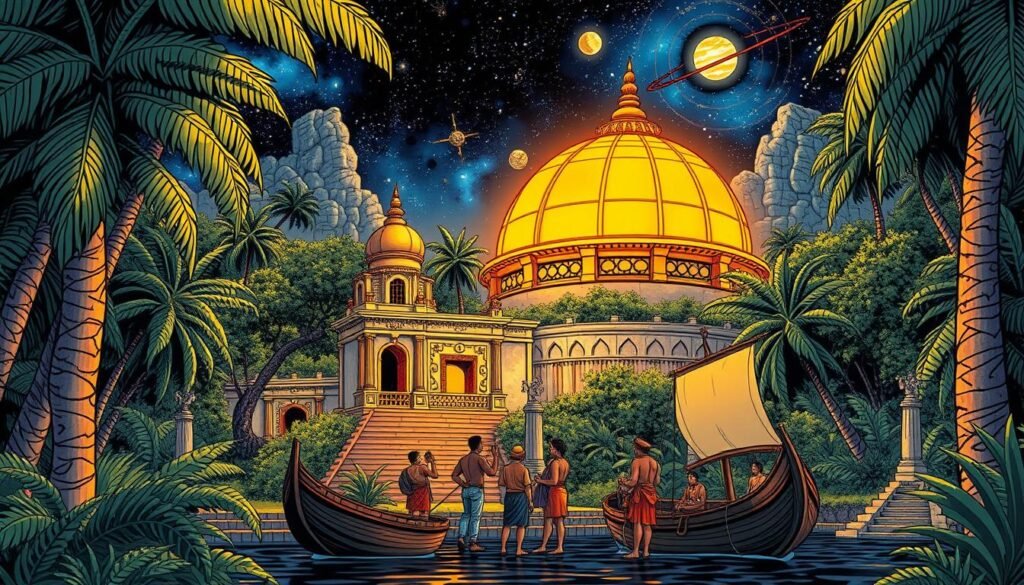
Another important constellation, Moroporo (Pleiades), appeared in January and guided the timing of planting. These celestial patterns were more than just markers; they were deeply embedded in cultural narratives. Stories about these stars were passed down through generations, preserving their significance.
Indigenous astronomers also tracked planetary alignments. These events were used for timekeeping and predicting seasonal changes. For instance, the star Marara in Bukidnon was associated with cloudy weather during planting season. Such detailed observation highlights their advanced understanding of the cosmos.
Below is a table summarizing the methods and significance of their celestial studies:
| Method | Significance |
|---|---|
| Tracking constellations | Guided agricultural and cultural activities |
| Observing planetary alignments | Used for timekeeping and seasonal predictions |
| Using natural landmarks | Enhanced precision in celestial observation |
| Oral traditions | Preserved knowledge of celestial patterns |
These practices demonstrate the ingenuity of pre-colonial Filipinos. Their ability to study the skies without modern tools laid the foundation for future scientific advancements. Their legacy continues to inspire modern understanding of the universe.
Celestial Navigation Techniques in Ancient Seafaring
Ancient seafarers in the Philippines mastered the art of navigating vast oceans by studying the patterns of the universe. They relied on the moon, stars, and their deep understanding of cosmology to guide their journeys across uncharted waters. This knowledge was not just practical but also deeply rooted in their cultural identity.

Utilizing the Moon and Stars
Pre-colonial navigators used the moon and stars as their primary tools for direction. The moon’s phases helped them predict tides and weather, while constellations like Balatik and Moroporo served as fixed markers. These celestial patterns were essential for long voyages, ensuring safe passage across the seas.
An astronomer-like figure often accompanied voyages. This individual interpreted celestial clues, such as the position of Polaris, to determine the ship’s location. Their expertise was crucial for navigating through challenging conditions, especially during nighttime or overcast skies.
Specific techniques included tracking the movement of stars across the night sky. Sailors used the horizon as a reference point, aligning stars to chart their course. This method required precision and a deep understanding of the universe’s rhythms.
Cultural beliefs also played a significant role. Stories about the stars were passed down through generations, blending practical navigation with mythology. For example, the Sama people believed that the star Mamahi Utara guided their ancestors safely home.
| Technique | Application |
|---|---|
| Moon Phases | Predicting tides and weather |
| Constellations | Marking directions and seasons |
| Polaris (Mamahi Utara) | Fixed reference point for navigation |
| Oral Traditions | Preserving navigational knowledge |
These ancient techniques highlight the ingenuity of pre-colonial seafarers. Their ability to navigate using the universe laid the foundation for modern maritime practices. Their legacy continues to inspire a deeper appreciation for the connection between humans and the cosmos.
The Role of Solar and Lunar Cycles in Indigenous Calendars
The cycles of the sun and moon were more than just natural phenomena for pre-colonial Filipinos—they were the foundation of their daily lives. These celestial patterns provided a basis for early agricultural models and the discovery of regular patterns in nature. Indigenous calendars were meticulously structured around these cycles, ensuring that farming, fishing, and cultural practices aligned with the rhythms of the cosmos.
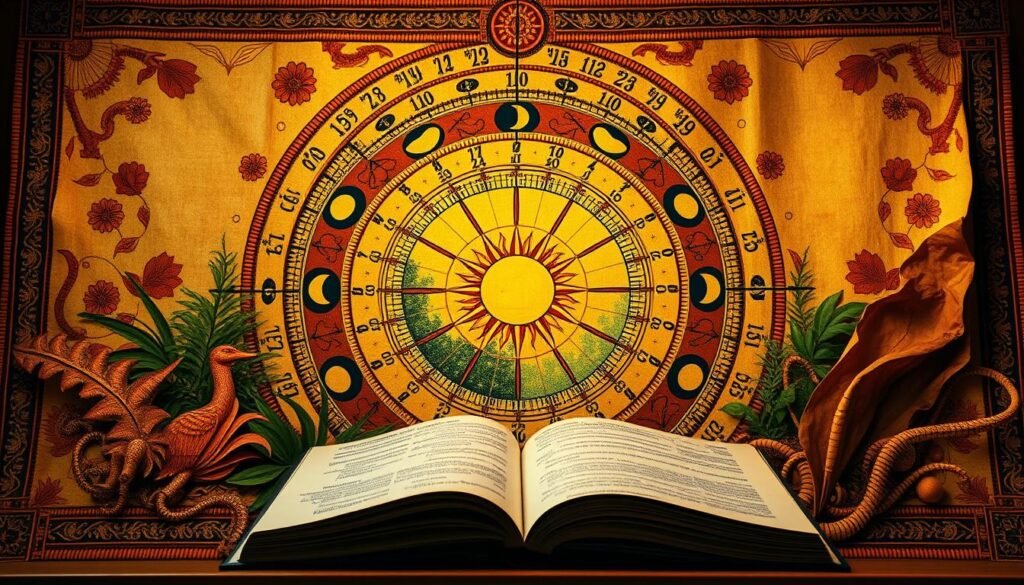
Seasonal Markers and Agricultural Timings
Pre-colonial Filipinos identified specific seasonal markers by observing the sun and moon. For example, the appearance of certain constellations signaled the start of planting or harvesting seasons. This systematic observation allowed them to create functional models for timekeeping, which were essential for survival in an agricultural society.
Modern research has validated these ancient calendrical systems. Studies show that the lunar cycle, which lasts approximately 28 days, was used to divide the year into 13 months. This discovery highlights the advanced understanding of celestial patterns among pre-colonial communities.
“The moon and sun were not just guides; they were the heartbeat of our ancestors’ lives, dictating when to plant, when to harvest, and when to celebrate.”
These cycles also underpinned ceremonial practices. Festivals and rituals were timed to coincide with significant celestial events, such as solstices or full moons. This integration of natural rhythms into cultural life demonstrates the deep connection between the environment and human activity.
| Cycle | Application |
|---|---|
| Solar | Marked seasons and agricultural activities |
| Lunar | Divided the year into 13 months |
| Constellations | Signaled specific farming tasks |
| Solstices | Guided ceremonial practices |
These ancient systems continue to inspire modern research into sustainable agricultural practices. By studying these models, we gain insights into how pre-colonial Filipinos harmonized their lives with the natural world. For more on how these practices influenced Philippine progress, explore this detailed analysis.
Tools and Instruments for Celestial Observation
From ancient instruments to modern satellites, the evolution of celestial observation tools is fascinating. Pre-colonial Filipinos used simple yet effective devices to study the skies, laying the groundwork for advanced methods in astrophysics. These tools were not just practical but also deeply embedded in their cultural practices.
Traditional tools like the astrolabe and kamal were essential for early navigators. The astrolabe, for example, helped determine the position of stars and planets. The kamal, a simple navigation device, was used to measure the angle of stars above the horizon. These instruments were crucial for maritime journeys and timekeeping.
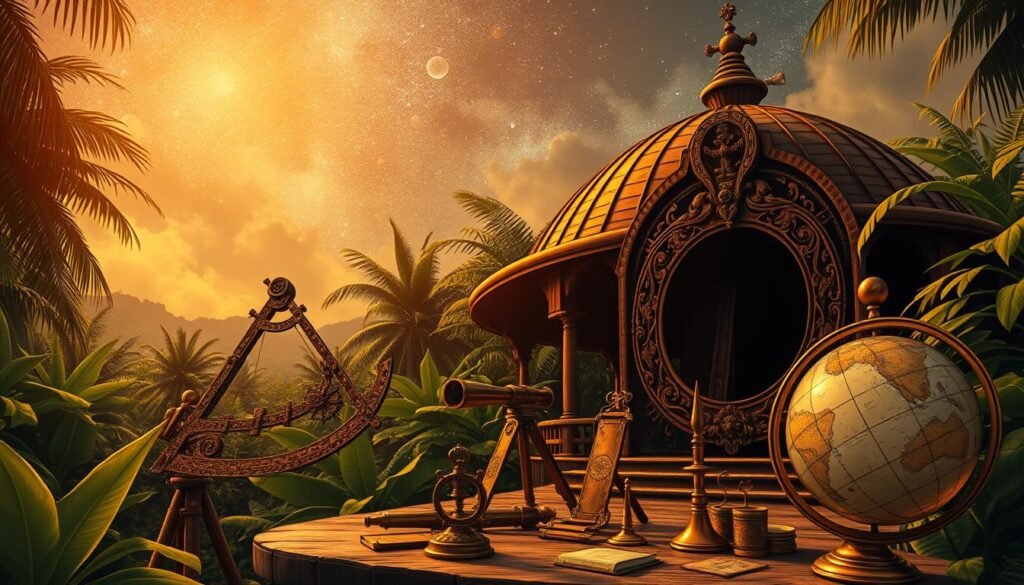
In contrast, modern technology has revolutionized celestial observation. Satellites, equipped with advanced sensors, provide detailed data about the universe. Charge-Coupled Devices (CCDs) used in telescopes can record over 90% of the light they capture, making them far more efficient than traditional photographic films.
Below is a comparison of traditional and modern tools:
| Tool | Traditional Use | Modern Application |
|---|---|---|
| Astrolabe | Measured star positions | Replaced by digital star charts |
| Kamal | Determined latitude | GPS systems now provide precise location data |
| Photographic Film | Recorded celestial images | CCDs offer higher sensitivity and resolution |
| Satellite | N/A | Provides real-time data on cosmic phenomena |
These advancements in tools and methods have transformed our understanding of the universe. While traditional instruments were limited by their simplicity, they inspired the development of sophisticated technologies in astrophysics. The journey from ancient tools to modern satellites highlights the enduring human quest to explore the cosmos.
Oral Traditions and the Transmission of Astronomical Knowledge
For centuries, oral traditions have been the backbone of preserving celestial knowledge among pre-colonial Filipinos. These stories were more than just tales; they were a vital way to pass down observations about the sun, stars, and other celestial phenomena. Through generations, these narratives ensured that practical learning and cultural wisdom remained alive.
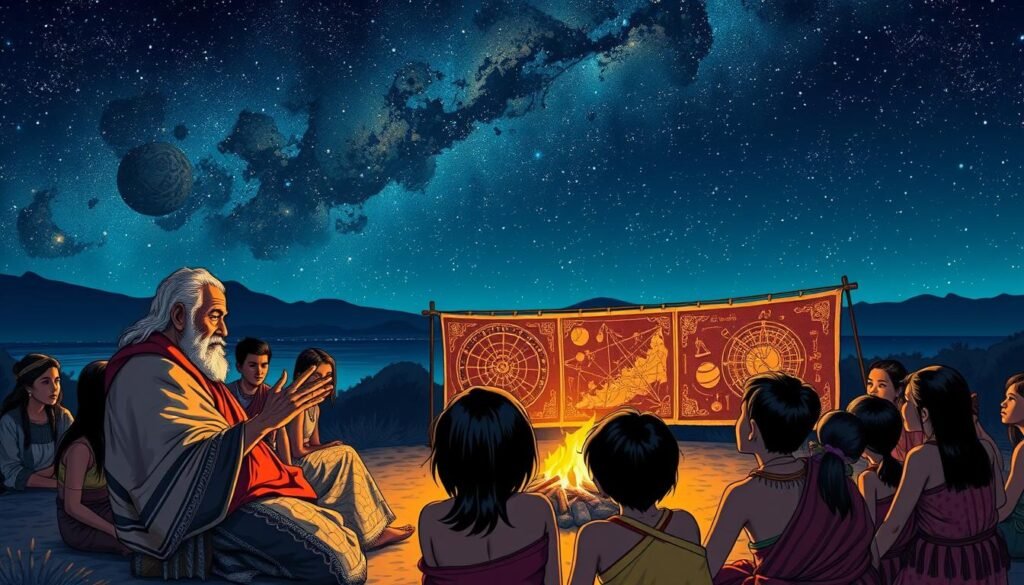
Storytelling as a Record Keeper
Storytelling served as a living repository for astronomical knowledge. Elders used vivid imagery and rhythmic patterns to describe the movements of the sun and stars. For example, the Sama people of Tawi-Tawi recounted how Polaris, or Mamahi Utara, guided their ancestors across the seas. These stories were not just entertainment but essential tools for survival.
In many indigenous communities, storytelling was a communal activity. During gatherings, elders would share tales that explained seasonal changes or celestial events. This ensured that each generation understood the history and significance of these natural patterns.
Legend and Learning Intertwined
Legends often blended practical knowledge with cultural beliefs. For instance, the story of Balatik, a constellation known as “Tres Marias,” was tied to the planting season. Its appearance signaled the time to prepare the fields. Such narratives made complex astronomical concepts accessible and memorable.
“The stars were our ancestors’ compass, and their stories were our maps.”
These traditions also highlighted the deep connection between humans and the cosmos. By weaving astronomical observations into myths, pre-colonial Filipinos created a unique history that continues to inspire modern understanding of the skies.
Below is a summary of how oral traditions preserved astronomical knowledge:
- Stories about the sun and stars guided agricultural and navigational practices.
- Rhythmic and sung narratives ensured easy memorization and transmission.
- Legends intertwined practical learning with cultural significance.
- Communal storytelling preserved knowledge across generations.
These methods showcase the ingenuity of pre-colonial Filipinos. Their ability to preserve and transmit knowledge through oral traditions remains a testament to their deep connection with the natural world.
Integration of Astronomy in Daily Filipino Life
Celestial observations shaped the daily lives of pre-colonial Filipinos in profound ways. From farming to fishing, the stars and sun provided a framework for their routines. These practices were not just about survival but also about maintaining societal order and cultural harmony.
Farmers relied on the moon and stars to determine the best times for planting and harvesting. For example, the Iraya tribe believed that planting during specific lunar phases, like the full moon, ensured a bountiful harvest. This systematic approach to agriculture was rooted in their understanding of celestial distance and patterns.

Fishermen also used the stars to navigate the seas. Constellations like Balatik and Moroporo served as guides, helping them locate fishing grounds. These observations were passed down through generations, ensuring that knowledge of the skies remained a vital part of their culture.
Beyond practical tasks, celestial observations reinforced societal order. Elders used the stars to mark important events, such as festivals or community gatherings. This integration of the cosmos into daily life created a sense of rhythm and stability.
Visual imagery played a key role in preserving this knowledge. Stories about the stars were often accompanied by vivid descriptions, making them easier to remember. These narratives ensured that the practical applications of celestial observations were not lost over time.
Routine sky-watching also helped in planning social and agricultural activities. For instance, the appearance of certain constellations signaled the start of planting season. This connection between the heavens and the earth was a cornerstone of pre-colonial Filipino life.
For more on how these practices influenced Philippine culture, explore this detailed analysis of ethnoastronomy in pre-colonial Philippine culture.
Influence of Celestial Myths on Cultural Practices
The night sky was more than a canvas of stars for pre-colonial Filipinos—it was a source of stories, rituals, and cultural identity. Myths about the world and its celestial wonders shaped their daily lives, blending practical knowledge with spiritual beliefs. These stories were passed down through generations, ensuring that the significance of the solar system and other celestial objects remained deeply rooted in their culture.

Mythical Interpretations of the Night Sky
Pre-colonial Filipinos saw the night sky as a tapestry of myths and legends. For example, the constellation Balatik, known as “Tres Marias,” was believed to be a hunter pursuing a wild boar. This story not only explained the stars’ arrangement but also guided agricultural activities. Its appearance signaled the start of planting season, connecting the world of farming with the movements of the heavens.
Another significant celestial object was the sun, often personified as a deity. The sun god, Araw, was revered for bringing light and life to the world. Rituals honoring Araw were held during solstices, celebrating the sun’s power and its role in sustaining crops. These myths reinforced the idea that the solar system was not just a physical phenomenon but a spiritual force.
Rituals and Social Celebrations
Celestial myths also played a central role in social celebrations. The appearance of the Pleiades, or Moroporo, marked the beginning of the harvest season. Communities gathered to give thanks, holding feasts and dances under the stars. These events strengthened social bonds and highlighted the importance of the world’s natural rhythms.
Another example is the Sama people’s use of Polaris, or Mamahi Utara, in their rituals. This star was seen as a guide for both physical journeys and spiritual quests. Rituals involving Mamahi Utara were believed to bring protection and prosperity, linking the celestial object to the community’s well-being.
“The stars were not just lights in the sky; they were the keepers of our ancestors’ wisdom and the markers of our traditions.”
Below is a summary of how celestial myths influenced cultural practices:
- Myths about constellations like Balatik guided agricultural activities.
- The sun god Araw was honored during solstices, connecting the solar system to spiritual beliefs.
- Harvest festivals celebrated the appearance of the Pleiades, reinforcing social unity.
- Rituals involving Polaris were believed to bring protection and prosperity.
These traditions show how pre-colonial Filipinos integrated their understanding of the world and its celestial wonders into their cultural identity. For more on the significance of these practices, explore this detailed analysis of celestial stories.
Comparison with Global Ancient Astronomical Developments
Across the globe, ancient civilizations looked to the skies for answers, and pre-colonial Filipinos were no exception. Their methods of observing celestial surfaces and interpreting the cosmos shared striking similarities with other cultures, yet they also had unique approaches that set them apart. By comparing these practices, we can better understand the universal question of how humans sought to make sense of the universe.
Shared Methods Across Cultures
Pre-colonial Filipinos, like the Egyptians and Babylonians, relied heavily on the moon and stars for navigation and timekeeping. The Egyptians tracked the rising of Sirius to predict the Nile’s flooding, while Filipinos used constellations like Balatik to mark planting seasons. Both cultures integrated celestial knowledge into their daily lives, demonstrating a deep connection to the natural world.
In Greece, philosophers like Pythagoras and Eratosthenes advanced the understanding of Earth’s shape and size. Similarly, pre-colonial Filipinos used natural landmarks to align their observations, creating functional models for timekeeping. These shared methods highlight a universal human curiosity about the cosmos.
Differences in Recording and Transmission
While Egyptians and Babylonians recorded their knowledge in hieroglyphs and cuneiform, pre-colonial Filipinos relied on oral traditions. Stories about the stars were passed down through generations, ensuring that practical learning remained alive. This approach contrasts with the written records of other cultures but was equally effective in preserving celestial knowledge.
For example, the Mayans developed a sophisticated calendar based on Venus, while Filipinos used the lunar cycle to divide their year into 13 months. These differences reflect the unique ways each culture approached the fundamental question of the cosmos.
Unique Contributions of Pre-Colonial Filipinos
Pre-colonial Filipinos made significant contributions to global astronomical knowledge. Their use of Polaris, or Mamahi Utara, as a fixed reference point for navigation was a groundbreaking achievement. This method allowed them to traverse vast oceans with remarkable precision, showcasing their ingenuity.
Additionally, their integration of celestial observations into cultural practices, such as festivals and rituals, highlights a holistic understanding of the universe. These contributions continue to inspire modern studies of the cosmos, as explored in this detailed analysis of ancient Greek astronomy and cosmology.
“The stars were not just lights in the sky; they were the keepers of our ancestors’ wisdom and the markers of our traditions.”
Below is a comparison of astronomical practices across cultures:
| Culture | Method | Application |
|---|---|---|
| Egypt | Tracked Sirius | Predicted Nile flooding |
| Babylon | Used cuneiform records | Predicted planetary movements |
| Greece | Mathematical models | Measured Earth’s size |
| Philippines | Oral traditions | Guided navigation and agriculture |
These comparisons reveal the rich diversity of ancient astronomical practices. By studying these methods, we gain a deeper appreciation for how different cultures approached the fundamental question of the cosmos. Pre-colonial Filipinos, with their unique contributions, played a vital role in this global narrative.
Technological Insights Gleaned from Early Astronomy
The quest to understand the stars has driven innovation across centuries. Early civilizations developed tools to observe the heavens, laying the foundation for modern technology. These innovations not only advanced our understanding of the cosmos but also transformed daily life.
One of the earliest breakthroughs was the invention of the astrolabe, a device used to measure the positions of stars. This tool, developed by ancient Greeks and later refined by Islamic scholars, became essential for navigation. It allowed sailors to determine their latitude, making long voyages safer and more efficient.
In the 20th century, the development of the Hubble Telescope marked a new era in celestial observation. Launched in 1990, Hubble provided unprecedented views of distant galaxies, nebulae, and other cosmic phenomena. Its discoveries confirmed many theories rooted in early astronomical research, such as the expansion of the universe.
Early observations also influenced practical technologies. For example, the atomic clock, calibrated using astronomical timekeeping, revolutionized global communication and navigation systems. This innovation, rooted in the study of celestial movements, now underpins GPS technology, which millions use daily.
“The stars have always been a source of inspiration, guiding us to create tools that shape our world.”
Below is a summary of key technological advancements inspired by early astronomy:
- The astrolabe, an ancient navigation tool, laid the groundwork for modern GPS systems.
- The Hubble Telescope confirmed theories about the universe’s structure and expansion.
- Atomic clocks, based on celestial timekeeping, revolutionized global communication.
- Early sky-watching practices influenced the development of advanced imaging and data analysis.
These examples highlight the profound impact of early astronomical research on modern technology. From navigation to communication, the study of the stars continues to shape our life in ways that were unimaginable centuries ago.
Navigation Methods: From Celestial Cues to Modern Techniques
The journey from celestial navigation to modern GPS systems reflects humanity’s relentless pursuit of precision. For centuries, mariners relied on the stars to determine their position at sea. These early methods, though simple, laid the foundation for the advanced systems we use today.
Early navigators used tools like the astrolabe and sextant to measure the angles of stars above the horizon. This allowed them to calculate their latitude with remarkable accuracy. The North Star, or Polaris, served as a fixed reference point, guiding sailors across vast oceans.
As technology advanced, so did navigation methods. The invention of the chronometer in the 18th century revolutionized timekeeping, enabling precise longitude calculations. This marked a significant leap in the scale of navigational accuracy, making long voyages safer and more efficient.
Today, satellite-based systems like GPS have transformed navigation. These systems provide real-time position data with unparalleled precision. The integration of multiple satellite networks, such as GLONASS and Galileo, has further enhanced global navigational capabilities.
“The stars were our ancestors’ compass, and satellites are ours today.”
Traditional celestial navigation continues to influence modern techniques. For example, military training programs often include celestial navigation to reduce reliance on technology. This ensures preparedness in scenarios where GPS signals may be compromised.
The future of navigation lies in the integration of traditional knowledge with cutting-edge technology. Innovations like autonomous ships and AI-driven navigation systems are set to redefine maritime travel. These advancements promise to expand the scale of navigational possibilities, making it safer and more efficient than ever before.
For more on the evolution of navigation, explore this detailed analysis of wayfinding and navigation.
Linking Astronomy with Environmental and Agricultural Cycles
The natural rhythms of the cosmos guided pre-colonial Filipinos in their daily lives, from farming to cultural rituals. Their deep understanding of celestial patterns allowed them to predict seasonal changes and plan agricultural activities with precision. This integration of the skies into their routines highlights the profound connection between the environment and human survival.
One key aspect of this relationship was the study of light. The position of the sun and moon provided essential cues for planting and harvesting. For example, the appearance of the Pleiades constellation signaled the start of the rainy season, a critical time for sowing crops. This understanding of celestial light ensured that farming activities aligned with the natural cycles of the earth.
Sudden astronomical events, such as meteor showers or celestial explosions, also influenced cultural perceptions. These phenomena were often interpreted as omens, shaping decisions about planting or harvesting. For instance, a meteor shower might be seen as a sign to delay planting until conditions were more favorable. This blend of observation and interpretation underscores the role of celestial events in agricultural planning.
Indigenous methods for predicting weather and farming seasons were remarkably sophisticated. Elders used the lunar cycle to determine the best times for planting, ensuring optimal crop growth. They also observed the behavior of animals and the appearance of certain stars to forecast weather patterns. This holistic approach to understanding the environment ensured that agricultural practices were both sustainable and effective.
Below is a summary of how celestial observations influenced agricultural cycles:
| Celestial Phenomenon | Agricultural Application |
|---|---|
| Pleiades Constellation | Signaled the start of the rainy season |
| Lunar Cycle | Guided planting and harvesting times |
| Meteor Showers | Interpreted as omens for planting decisions |
| Solar Position | Marked seasonal changes for crop rotation |
The integration of celestial light and environmental understanding into daily life was a cornerstone of pre-colonial Filipino culture. These practices not only ensured survival but also fostered a deep respect for the natural world. By studying the skies, they created a legacy of knowledge that continues to inspire modern agricultural and environmental practices.
Modern Implications for Indigenous Astronomy and Navigation
The wisdom of ancient navigators continues to shape our modern understanding of the skies. Indigenous techniques, once vital for survival, now inspire advancements in science and technology. These methods, rooted in centuries of observation, offer valuable insights for contemporary research.
Traditional knowledge has influenced current navigational practices and technological laws. For example, the use of celestial cues by pre-colonial Filipinos laid the groundwork for modern GPS systems. This addition of ancient wisdom to modern tools highlights the enduring relevance of indigenous methods.
Modern scientists like James have drawn inspiration from these techniques. His work in astronomy-related fields demonstrates how traditional knowledge can enhance contemporary research. By integrating indigenous practices, researchers are uncovering new ways to study the cosmos.
“The stars were our ancestors’ compass, and they continue to guide us in our quest for knowledge.”
Adaptations of ancient techniques are now used in fields like satellite technology and space exploration. For instance, the study of celestial patterns has informed the design of satellite constellations. These advancements, rooted in indigenous laws of observation, are transforming our understanding of the universe.
Below are key ways indigenous knowledge influences modern science:
- Traditional star mapping techniques inspire modern satellite navigation systems.
- Celestial observations contribute to the development of advanced imaging technologies.
- Indigenous methods enhance our understanding of planetary movements and seasonal changes.
The long-lasting impact of these methods extends beyond technology. They also play a crucial role in preserving cultural identity. By recognizing the value of indigenous knowledge, we honor the legacy of those who first looked to the stars for guidance.
For more on the significance of these practices, explore this detailed analysis of Indigenous astronomical knowledge.
Conclusion
The rich legacy of pre-colonial Philippine astronomical and navigational traditions highlights the ingenuity of early Filipinos. Their deep understanding of celestial patterns not only guided daily life but also laid the groundwork for modern science. From tracking asteroids to observing chemical processes in space, these ancient methods continue to inspire contemporary research.
Indigenous practices, such as using stars for navigation and lunar cycles for agriculture, remain relevant today. These traditions have influenced technological advancements, from GPS systems to space exploration. The integration of natural phenomena into cultural practices showcases the profound connection between humans and the cosmos.
Looking ahead, these ancient insights can inspire future generations to explore the universe. By blending traditional knowledge with modern science, we can deepen our understanding of the cosmos. For more on the evolution of celestial studies, explore this detailed analysis.
FAQ
What role did astronomy play in pre-colonial Philippine culture?
Astronomy was deeply integrated into daily life, guiding navigation, agriculture, and cultural practices. Indigenous Filipinos relied on celestial observations to mark seasons, plan harvests, and navigate the seas.
How did ancient Filipinos use stars for navigation?
They used the positions of stars, the moon, and other celestial objects to determine direction and distance. This knowledge was passed down through oral traditions and practical experience.
What tools did pre-colonial Filipinos use for celestial observation?
While specific instruments are not well-documented, they likely used simple tools like sticks, stones, and natural landmarks to track the movement of celestial bodies.
How were lunar and solar cycles used in indigenous calendars?
These cycles helped mark time for agricultural activities, rituals, and social events. The moon’s phases were particularly important for determining planting and harvesting seasons.
What is the significance of oral traditions in preserving astronomical knowledge?
Oral traditions, including myths, legends, and storytelling, served as a way to record and transmit celestial knowledge across generations without written records.
How did celestial myths influence Filipino cultural practices?
Myths about the night sky shaped rituals, celebrations, and social customs. These stories often explained natural phenomena and reinforced community bonds.
How does pre-colonial Philippine astronomy compare to global ancient practices?
Like other ancient cultures, Filipinos developed sophisticated methods of celestial observation. However, their techniques were uniquely adapted to their environment and seafaring lifestyle.
What modern implications does indigenous astronomy have today?
It highlights the importance of preserving traditional knowledge and integrating it with modern science, particularly in fields like environmental studies and sustainable agriculture.
Source Links
- National Planetarium – National Museum
- Rethinking colonialism through early modern global diplomacy: A tale of Pampangan mobility | Journal of Global History | Cambridge Core
- Age of Discovery
- Research Guides: Philippines: Philippine Boats & Navigation
- Astronomy – Ancient, Celestial, Observations | Britannica
- History of astronomy
- Celestial cartography
- Mapping the Stars: A Guide to Celestial Maps and Their History
- ESA Science & Technology – A history of astrometry
- Stars Through the Eyes of Ancient Filipinos • THE ASWANG PROJECT
- Astronomy | Definition, History, Discoveries, & Facts | Britannica
- Universe Today
- The Lunar Calendar, Explained – Pimachiowin Aki
- The History of Calendars and How They Evolved – Calendar
- List of astronomical instruments
- Visible-Light Detectors and Instruments | Astronomy
- The Circulation of Astronomical Knowledge in the Ancient World
- Knowledge and power in oral cultures (Chapter Two) – Knowledge and Power in Prehistoric Societies
- Indigenous knowledge of astronomical star positions…
- The Role of Astronomy in Religious and Cultural Practices
- 7 Ancient Cultures and How They Shaped Astronomy – IAU Office of Astronomy for Development
- Astronomy in the Scientific Revolution
- 2.2 Ancient Astronomy – Astronomy 2e | OpenStax
- Space exploration – Astronomy, Technology, Discovery | Britannica
- International Astronomical Union | IAU
- Terrestrial Navigation: Methods & Techniques
- Celestial Navigation: Navigating by the Stars – The…
- The star compass – kāpehu whetū
- The Role of Astronomy in Maya Agriculture
- Astronomy and Culture – Science & Education
- Open Access proceedings Journal of Physics: Conference series
- Indigenous Interests in Outer Space: Addressing the Conflict of Increasing Satellite Numbers with Indigenous Astronomy Practices
- Aboriginal astronomy can teach us about the link between sky and land | Kirsten Banks
- Dawes Review 5: Australian Aboriginal Astronomy and Navigation | Publications of the Astronomical Society of Australia | Cambridge Core
- 1.9 A Conclusion and a Beginning – Astronomy 2e | OpenStax
- Science and the Educated American: A Core Component of Liberal Education

